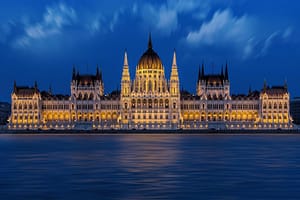PARKS
The City Park
The City Park is situated behind Heroes’ Square, one of Hungary’s World Heritage Sites. It was built in the 18th century. The park is huge, covering an area of 302 acres. There are many great visitor attractions located within its territory, such as the Municipal Zoological and Botanical Garden, Vajdahunyad Castle and the Museum of Fine Arts. Traffic lanes also go through the park. The park has an ice-skating rink which is the largest artificial ice surface in Europe, and it gets turned into a lake with boats for rent in the summer. The park also includes a children’s playground. The City Park is a great recreational space whether you’re interested in casually strolling around or visiting some of its main sights.
Margaret Island
Located on a 2.5 kilometes long island on Danube River, the historical Margaret Island is a notable landmark of Budapest. All motorized traffic has been banned on this island, except for one single bus line, since it is the primary place of recreation in Budapest. The many features of the park include an outdoor summer thermal spa, a professional swimming pool where the Olympic champion water polo team trains continually, the ruins of a 13th-century Dominican cloister, a small wildlife park, a Japanese garden and a 5 kilometers long professional jogging circle along the sides of the island. There are also several lovely restaurants, two luxury hotels and a rose garden. Cyclists and families appreciate the car-free environment. The park also features the biggest fountain in Budapest, which plays relaxing music every half-an-hour.
MUSEUMS
Hungarian National Gallery
The Hungarian National Gallery is an overwhelming collection spread across four floors and four wings of the palace that traces Hungarian art from the 11th century to the present day. The largest collections include medieval and Renaissance stonework, Gothic wooden sculptures and panel paintings and late-Gothic winged altars. The museum also has an important collection of Hungarian paintings and sculpture from the 19th and 20th centuries.
Aquincum Museum
The most complete Roman civilian town in Hungary was built around 100 AD and became the seat of the Roman province of Pannonia Inferior in AD 106. Visitors can explore its houses, baths, courtyards, fountains and sophisticated underfloor heating systems, as well as a recreation of a Roman painter’s dwelling and Symphorus Mithraeum. The purpose-built Aquincum Museum, just inside the entrance, puts the ruins in perspective, with a vast collection of Roman daily life objects and wall paintings.
Hungarian National Museum
The Hungarian National Museum houses the nation’s most important collection of historical relics in an impressive neoclassical building, purpose built in 1847. Exhibits on the 1st floor trace the history of the Carpathian Basin from earliest times to the arrival of the Magyars in the 9th century; the ongoing story of the Magyar people resumes on the 2nd floor from the conquest of the basin to the end of communism.
MARKETS
Budapest Central Market Hall
Some events make the Central Market Hall even more colourful: each week a new country presents its culture, cuisine, markets, etc. during the National Days in the Central Market Hall. Tours in the Market Hall are offered along with wine and food tasting in other special venues. Take a look at Budapest Market and Food Tour highlights here. Shopping, eating, drinking and people watching in a beautiful 19th century market hall in the city centre. Who wouldn’t want to see it? The Central Market Hall in Budapest is geared most toward tourists, and is priced accordingly, but many locals buy their goods here too.
Feny utca Market Hall
One of the biggest food markets in Budapest, and is the most frequented on the Buda side of the city. If you walk up or down from Szell Kalman Square (former Moszkva ter) to the Castle Hill, you can drop in to take a look at the fresh goods, eat the yummy Hungarian snack called Langos, and try some local cheeses, salamis, fruits, vegetables, and more.
Lehel Market Hall (Lehel Piac)
big favourite of locals, penny pinching Hungarians (i.e. most housewives and market goers in Budapest, including my grandmother). Lehel Market Hall is geared the least toward tourists (and is priced accordingly). Its architecture is kitschy and colourful, but the atmosphere is authentic Hungarian market like.

